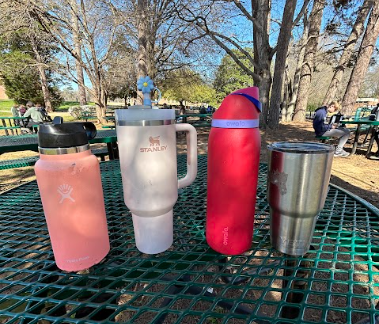
Photo contributed by Eleanor Haviland
The rise of the anti-single-use plastic water bottle movement has incited a rise in the reusable water bottle industry. In the past 20 years, names such as Camelbak, S’well, Hydroflask, and many others have rotated through the trend cycles impacting both our water consumption and our overconsumption of new products. A trip to Target or a quick shop on Amazon can supply you with the newest fad but the impact of this modern movement of always needing trendy water bottles could prove more harmful than it seems. With the increase of social media and influencers, water bottles have become more of a status symbol or collector’s item than a resource for hydration, affecting people’s pockets, the environment, and society.
Staying on each water bottle trend comes with a hefty price tag. There have always been popular brands but when comparing to icons of the past: the classic green Gatorade bottle at $6 and a 32-ounce Nalgene is $16, with trends of the present: 30-ounce Stanley Cup is $35 and a 32-ounce Hydroflask is $30, the price disparity is glaring. Sometimes the water bottle itself isn’t enough and one needs accessories to enhance it . A rubber bottom to “protect” the easily dented metal, an interchangeable lid to match your mood for the day, or a cute silicone animal to cover your straw can all be purchased to personalize the hydration station. The sticker industry is also safe as long as people keep curating the perfect gallery on their water bottles only to misplace it the next month. Are these customizations super fun and cute? Yes. Are they also an arbitrary expense on top of the already stupidly expensive water bottle? Yes again.
Even worse than your bank account’s well-being is the health of our environment. While reusable water bottles are far more eco-friendly than their single-use plastic counterparts, the impacts of metal manufacturing and the bottle’s disposal method can prove just as harmful. According to Treehugger.com, many water bottle manufacturers use only virgin materials in production, despite the vast amount of recyclable stainless steel and aluminum available.” Not only is obtaining metal ore harmful to the ecosystem, but most of the United States’s supply is outsourced meaning tons of emissions from international transport alone. The carbon spewing doesn’t stop at mining, with manufacturing exacerbating air and water pollution. Treating, shaping, and painting the metal for these trendy water bottles involves the use of toxic chemicals that inevitably make it into our air and waterways and eventually wreak havoc on our ecosystems and human health.
Perhaps the biggest long-term effect of these water bottles is their disposal. The idea of reusable water bottles is to relieve the strain of extra plastic in our landfills but even worse than plastic in landfills is metal that can’t be recycled. Contrary to popular belief, you can’t just recycle metal with your cardboard and paper products, your decrepit dented receptacle requires specific after-life treatment at a metal recycling plant. Many bottles contain layers of insulation with mixes of aluminum and stainless steel making the recycling process difficult. In many cases, if it isn’t easily melted down it is rejected by the metal recycling plant and sent to a landfill anyway. In a landfill, the metal can potentially leach toxic chemicals to its surroundings, practically defeating the purpose of a reusable water bottle in the first place.
While buying a 40-pack of plastic water bottles is by no means better than refilling your Owala, it is important to consider moderation when feeling the urge to jump on the new water bottle bandwagon, and at the end of the day, we all need water somehow.
